How many species of birds are nocturnal?
Nocturnal birds are fascinating creatures that have adapted to thrive in the darkness. These birds exhibit unique behaviors and characteristics that allow them to navigate, hunt, and communicate at night. In this blog post, we’ll explore some of the most intriguing nocturnal bird species, their habitats, and behaviors.
At a Glance
What Are Nocturnal Birds Species?
Nocturnal birds are species that are primarily active during the night. They have evolved various adaptations, such as enhanced night vision and acute hearing, to help them survive and hunt in the dark.
These adaptations make them well-suited for their nocturnal lifestyles.
List Of Nocturnal Birds
| Bird | Description |
|---|---|
| Owl | Known for excellent night vision and silent flight. |
| Nightjar | Camouflaged, ground-nesting birds with soft plumage. |
| Nighthawk | Often seen at dusk and dawn, feeding on insects in flight. |
| Common Poorwill | The only bird known to hibernate during cold months. |
| Oilbird | Feeds on fruit and uses echolocation to navigate in the dark. |
| Stone Curlew | Large-eyed bird, active during the night, often found in dry areas. |
| Frogmouth | Resembling owls, they sit still and blend into trees. |
Characteristics of Nocturnal Birds
Enhanced Vision: Many nocturnal birds have large eyes with a high number of rod cells, allowing them to see in low light conditions.
Keen Hearing: These birds often have excellent hearing, which helps them locate prey in the dark.
Silent Flight: Some nocturnal birds, like owls, have specialized feathers that enable silent flight, aiding in stealth hunting.
Common Nocturnal Bird Species
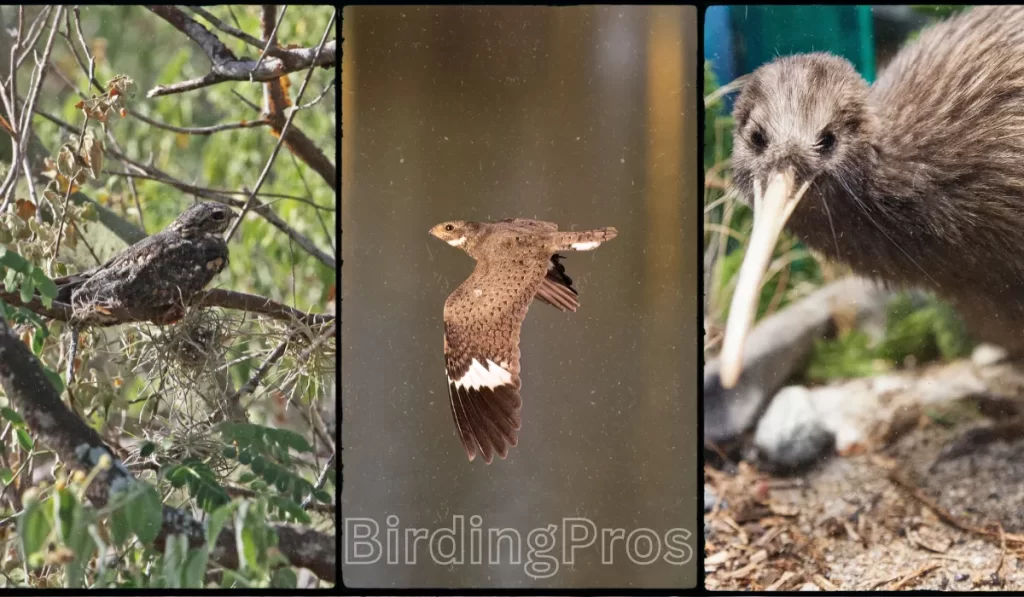
They use their excellent camouflage to blend into their surroundings during the day and become active hunters at night. These birds showcase the remarkable diversity and specialization of nocturnal avian life.
Owls
Owls are perhaps the most well-known nocturnal birds. They are found in various habitats worldwide and are known for their distinctive calls and silent flight.
Nightjars
Nightjars are medium-sized nocturnal birds with camouflaged plumage, making them difficult to spot during the day. They are known for their churring calls at night.
Nighthawks
Nighthawks are insectivorous birds that are active during twilight and nighttime. They have long wings and a distinctive “booming” sound during flight displays.
Kiwi Birds
Native to New Zealand, kiwi birds are nocturnal and flightless. They have a keen sense of smell and use their long beaks to forage for insects and worms at night.
Nocturnal Bird Species A Quick View Table
| Bird Species | Habitat | Diet | Unique Feature |
|---|---|---|---|
| Barn Owl | Open countryside | Small mammals | Heart-shaped face |
| Tawny Frogmouth | Forests and woodlands | Insects and small animals | Camouflaged plumage |
| Great Horned Owl | Diverse habitats | Various prey | Tufts on head (“horns”) |
| Common Nighthawk | Open areas | Flying insects | Aerial acrobatics |
| Eastern Whip-poor-will | Woodlands | Insects | Repetitive call “whip-poor-will” |
Read More: Feathers and Fortitude: How Do Birds Survive in the Desert?
Adaptations for Nocturnal Life
Nocturnal bird species have evolved specific adaptations to thrive in their nighttime habitats. These adaptations are essential for their survival and successful hunting during the dark hours. Here’s why these adaptations are crucial:
Vision Adaptations
Nocturnal birds have large eyes with a high density of rod cells, which are more sensitive to low light. This adaptation allows them to see better in the dark compared to diurnal birds.
Hearing Adaptations
The asymmetrical ears of many nocturnal birds, such as owls, enable precise localization of sounds, helping them detect prey even without visual cues.
Silent Flight
Owls, in particular, have serrated wing feathers that reduce noise during flight. This silent flight is crucial for sneaking up on prey without being detected.
Overall, these adaptations are essential for the survival and success of nocturnal birds in their specialized niches, where they face unique challenges and opportunities associated with life in the dark.
Australian Nocturnal Bird Species
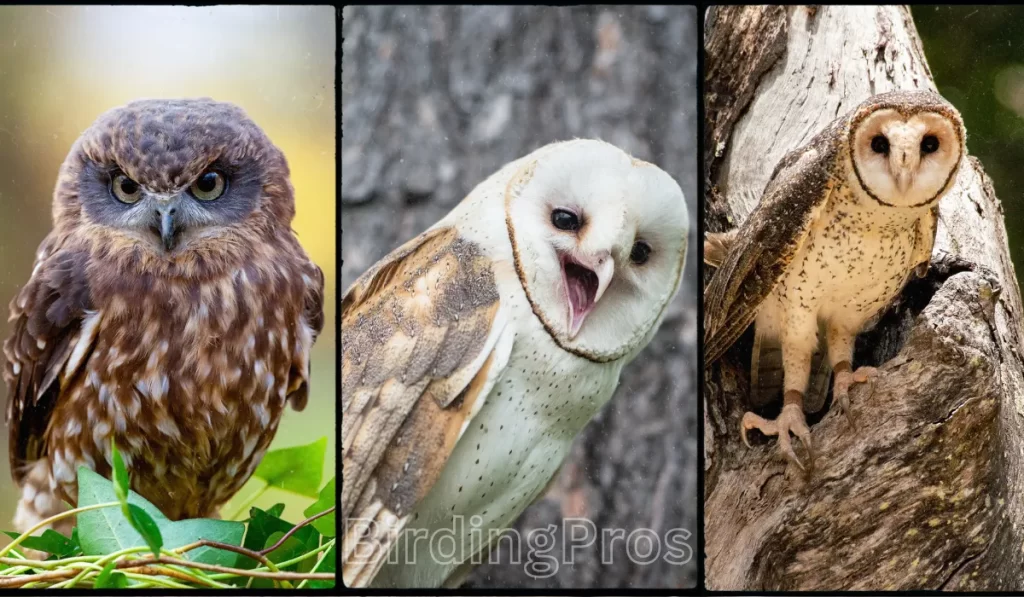
Owls
Southern Boobook
The Southern Boobook is the smallest and most widespread owl in Australia. Known for its distinctive “boo-book” call, this owl inhabits a variety of environments, including forests, woodlands, and urban areas.
Barn Owl
Barn Owls are recognizable by their heart-shaped faces and white, speckled plumage. They prefer open habitats such as grasslands and farmlands, where they hunt small mammals and insects.
Australian Masked Owl
This large owl is characterized by its masked face and powerful build. Australian Masked Owls are typically found in forests and wooded areas, preying on rodents and other small animals.
Powerful Owl
The Powerful Owl is Australia’s largest owl, known for its deep hooting calls. It resides in eucalypt forests and woodlands, primarily feeding on possums and other small mammals.
Frogmouths
Tawny Frogmouth
The Tawny Frogmouth is a master of camouflage, often resembling a broken branch when perched. These birds are common in forests, woodlands, and suburban areas, feeding on insects, small mammals, and reptiles.
Papuan Frogmouth
Found in northern Australia, the Papuan Frogmouth has a large, wide mouth and distinctive “ooom-ooom” calls. It prefers dense forests and mangroves, where it hunts insects and small vertebrates.
Nightjars
Australian Owlet-nightjar
This small, agile bird is known for its sharp, repetitive calls. The Australian Owlet-nightjar inhabits woodlands and forests, feeding on insects caught in flight.
Other Nocturnal Birds
Eastern Grass Owl
The Eastern Grass Owl is found in grasslands and wetlands across northern and eastern Australia. It is known for its long legs and distinctive screeching calls, primarily feeding on small mammals and insects.
White-throated Nightjar
This nocturnal bird has a cryptic plumage that blends into its forest and woodland habitats. The White-throated Nightjar feeds on flying insects, often catching them in mid-air during the night.
FAQs about Nocturnal Birds
Why do some birds prefer to be active at night?
Nocturnal birds may prefer the night due to reduced competition for food, fewer predators, and the advantage of cooler temperatures.
How can you observe nocturnal birds?
Observing nocturnal birds can be done by visiting their habitats during dusk and dawn, using night vision equipment, or joining guided night birding tours.
Nocturnal birds in Wisconsin species?
- Eastern Screech-Owl
- Great Horned Owl
- Barn Owl
- Barred Owl
- Northern Saw-whet Owl
- Common Nighthawk
- Eastern Whip-poor-will
Australian nocturnal bird species?
- Tawny Frogmouth
- Southern Boobook
- Barn Owl
- Australian Masked Owl
- Powerful Owl
- Eastern Grass Owl
- Nightjars
Conclusion
Nocturnal birds are extraordinary examples of nature’s adaptability. From the silent flight of owls to the camouflaged plumage of nightjars, these birds have evolved unique traits to master the night.
Understanding these nocturnal bird species not only enriches our knowledge of avian diversity but also highlights the importance of preserving their habitats.


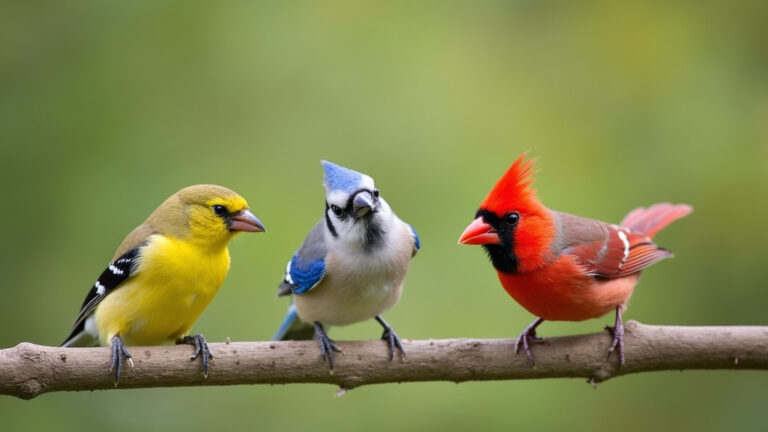

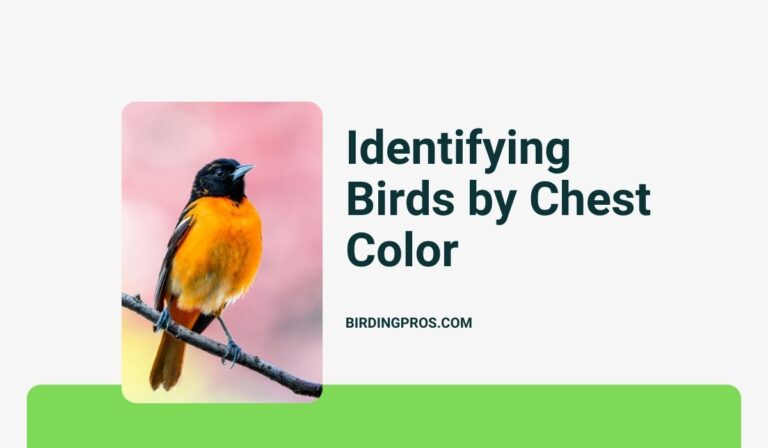
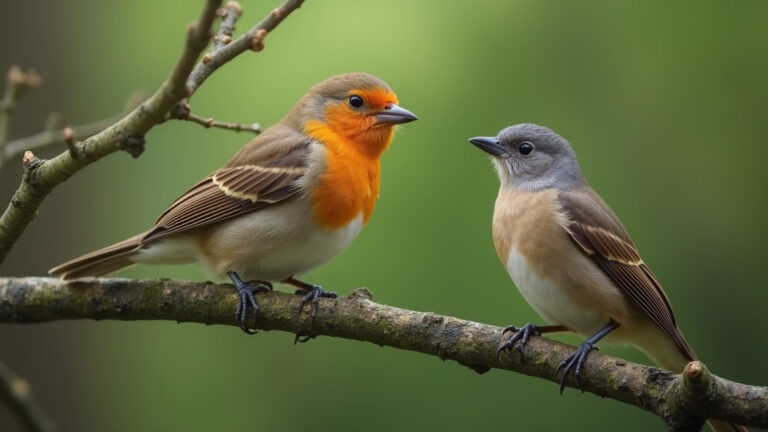
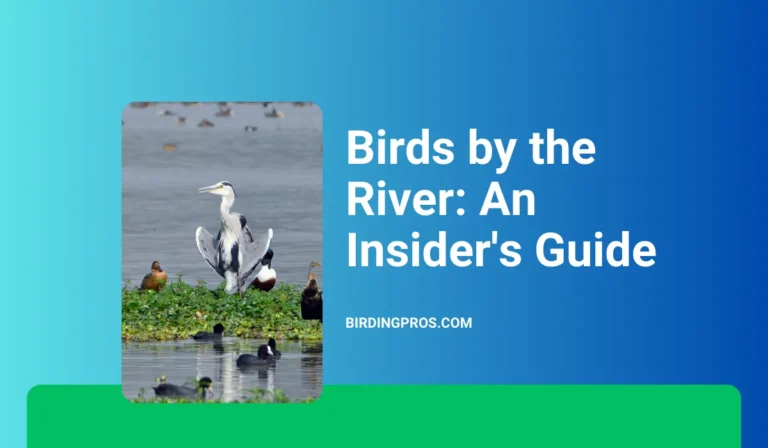
One Comment
Comments are closed.